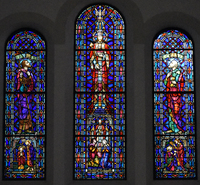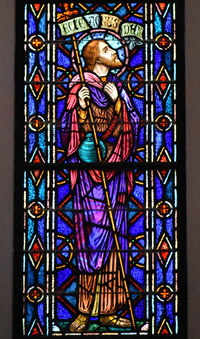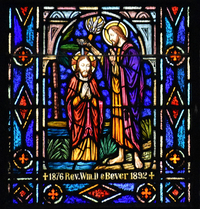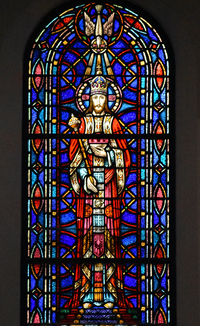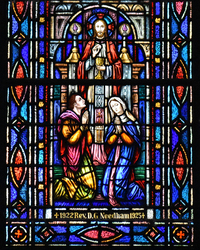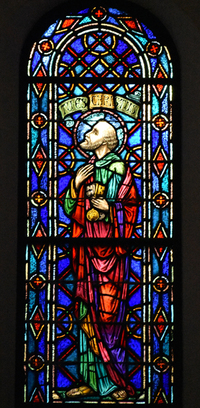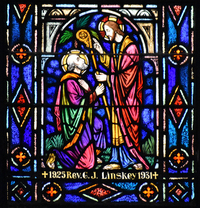Window
Building Name: St. John the Baptist Catholic ChurchCity: Ypsilanti
Window Shape: 6 (gothic arched, more than 2 vertical sections)
Date of Window: 1933
Subject/Title of Window: John the Baptist/Christ the King/Peter
Brief Description of Subject: This three lancet window, memorializing three former pastors at this Church, is located directly behind the altar. The figures of John the Baptist and Peter are seen looking up at Christ the King. At the bottom of each lancet is a scene.
Lancets left to right:
John the Baptist. John, looking up at Christ the King, is pictured holding a walking stick topped by a tau cross as well as a banner that reads, "Ecce Agnus Dei," Latin for, "Behold! the Lamb of God" --- words spoken by John as he saw Jesus approaching him (John 1:29). John is costumed in a red robe (martyrdom) over a camel hair garment (Matthew 4:4). Attached to his belt is a water bottle (baptism).
Scene. Pictured is John's baptism of Jesus, as covered in John 1:28 - 34. "And John [the Baptist] offered testimony, saying: For I saw the Spirit descending from heaven like a dove; and remained upon him. And I did not know him. But he who sent me to baptize with water said to me: 'He over whom you will see the Spirit descending and remaining on him, this is the one who baptizes with the Holy Spirit.' And I saw, and I gave testimony: that this one is the Son of God," (CPDV).
Christ the King. Christ, with the crown of a king, is holding a scepter (kingly authority) in one hand, and a globus cruciger (dominion over the world) in the other. He is costumed in red (human) and blue (divine). Over his head is the Holy Spirit, symbolized by a descending dove (John 1:32).
Scene. Christ is seen at the moment in the Catholic Mass where the celebrant turns to the people, and slightly raising a Sacred Host, says out loud, "Behold the Lamb of God, behold Him who taketh away the sins of the world." This image pictures the Catholic beliefs "in persona Christi" (the priest at Mass serves "in the person of Christ") and "transubstantiation" (the consecrated host is the body of Christ).
Peter. Peter, looking up at Christ the King, is pictured holding the "keys of the kingdom: Matthew 16:19 CPDV). By tradition, Peter will hold two keys, the gold one is the key to heaven, while the silver is the key to earth. Above his head is a scroll with the words, "Tu Es Christus," (Matthew 16:16 Vulgate), which translates to "You are Christ" --- This is Peter's response to Jesus' question "Who am I?" After this, Christ tells Peter that he is giving him the "keys of the kingdom."
Scene. Christ is seen passing an ornate shepherd's crook (crosier) to Peter. This represents Jesus' designating Peter to be the head of the Christian community. In scriptures this is occurs, not only before the Resurrection with the giving of the "keys of the kingdom," but also, after the Resurrection in John 21:15 - 19 , where, just before his Ascension, Christ emphatically tells Peter that he is to feed and take care of Christ's sheep (Christian community). The shepherd's crook is a symbol of the office of a bishop and is always to be held by him, as in this scene, with the crook facing the person being addressed. Peter is considered to be the first to hold the position of "Bishop of Rome" (Pope).
Inscriptions: 1925 Rev. C.J. Linskey 1931
1922 Rev. R.G. Needham 1925
1876 Rev. Wm. DeBever 1892
Condition of Window: Good
Height: 12'
Width: 46"
Type of Glass and Technique: Antique or Cathedral Glass, Lead Came, Vitreous Paint
John the Baptist/Christ the King/Peter
John the Baptist
John's Baptism of Jesus
Christ the King
In Persona Christi
Peter
Christ Gives Peter the Crosier
The MSGC is a constantly evolving database. Not all the data that has been collected by volunteers has been sorted and entered. Not every building has been completely documented.
All images in the Index are either born-digital photographs of windows or buildings or are scans of slides, prints, or other published sources. These images have been provided by volunteers and the quality of the material varies widely.
If you have any questions, additions or corrections, or think you can provide better images and are willing to share them, please contact donald20@msu.edu

